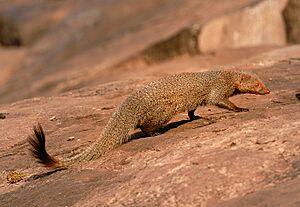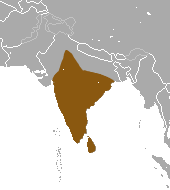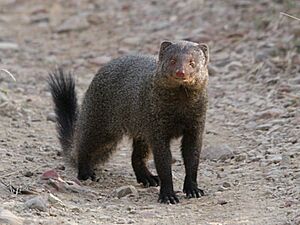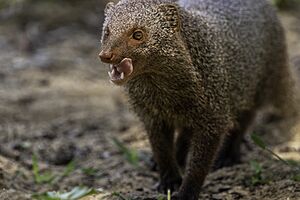Ruddy mongoose facts for kids
Quick facts for kids Ruddy mongoose |
|
|---|---|
 |
|
| Conservation status | |
| Scientific classification | |
| Genus: |
Urva
|
| Species: |
smithii
|
 |
|
| Ruddy mongoose range | |
| Synonyms | |
|
Herpestes smithii |
|
The ruddy mongoose (Urva smithii) is a type of mongoose. These animals live in the hill forests of India and Sri Lanka.
Contents
What Does It Look Like?
The ruddy mongoose has brownish, rough fur. Its fur is long on its back legs but shorter on other parts of its body. From its head to its body, it measures about 40 to 45 centimeters (16 to 18 inches). Its tail is about 36 centimeters (14 inches) long.
Male ruddy mongooses are bigger and heavier than females. Males can weigh around 2.2 kilograms (4.9 pounds), while females weigh about 1.2 kilograms (2.6 pounds). Their tail is quite long, making up about 75% to 90% of their body length. You can tell them apart from the Indian grey mongoose because they are a bit larger and have a tail with a jet-black tip.
Where Do They Live?
Ruddy mongooses mostly live in forests. They like quiet, hidden places. Sometimes, they are also seen in quiet rice fields or more open areas.
Its Scientific Name
The scientific name Herpestes smithii was first suggested by John Edward Gray in 1837. He named it after looking at an animal sample at the British Museum Natural History. Today, scientists believe that all Asian mongooses belong to a group called Urva.
There are a few different types, or subspecies, of the ruddy mongoose:
- U. s. smithii
- U. s. thysanurus
- U. s. zeylanius
What Do They Do?
The ruddy mongoose often carries its black-tipped tail curved upwards. This makes it easy to spot from a distance. Like other mongooses, it hunts both during the day and at night. They eat birds, rat snakes, land monitors (a type of lizard), rodents, and snails.
Ruddy mongooses are usually solitary animals, meaning they like to be alone. You might see them in pairs during the mating season. However, sometimes a mother and her pups are seen together in groups of about five animals.
They live in thick jungles, at the edges of forests near rice fields, and in tea plantations. If they see humans, they quickly hide in a crack or under a rock. If they get trapped, they will fight bravely, making loud, high-pitched cries.
Ruddy Mongooses in Culture
In Sri Lanka, people often see the ruddy mongoose as an animal they don't like, or even a pest. Another animal, the golden palm civet (Paradoxurus zeylonensis), is also sometimes called hotambuwa in Sri Lanka. This is because it looks similar to the ruddy mongoose and has a similar color. However, the golden palm civet is a completely different species that only lives in Sri Lanka.




